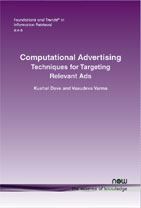Computational Advertising: Techniques for Targeting Relevant Ads
By Kushal Dave, International Institute of Information Technology, Hyderabad, India, kushal.dave@research.iiit.ac.in | Vasudeva Varma, International Institute of Information Technology, Hyderabad, India, vv@iiit.ac.in
Abstract
Computational Advertising, popularly known as online advertising or Web advertising, refers to finding the most relevant ads matching a particular context on the Web. The context depends on the type of advertising and could mean – content where the ad is shown, the user who is viewing the ad or the social network of the user. Computational Advertising (CA) is a scientific sub-discipline at the intersection of information retrieval, statistical modeling, machine learning, optimization, large scale search and text analysis. The core problem addressed in Computational Advertising is of match-making between the ads and the context.
CA is prevalent in three major forms on the Web. One of the forms involves showing textual ads relevant to a query on the search page, known as Sponsored Search. On the other hand, showing textual ads relevant to a third party webpage content is known as Contextual Advertising. The third form of advertising also deals with the placement of ads on third party Web pages, but the ads in this form are rich multimedia ads – image, video, audio, flash. The business model with rich media ads is slightly different from the ones with textual ads. These ads are also called banner ads, and this form of advertising is known as Display Advertising.
Both Sponsored Search and Contextual Advertising involve retrieving relevant ads for different types of content (query and Web page). As ads are short and are mainly written to attract the user, retrieval of ads pose challenges like vocabulary mismatch between the query/content and the ad. Also, as the user’s probability of examining an ad decreases with the position of the ad in the ranked list, it is imperative to keep the best ads at the top positions. Display Advertising poses several challenges including modeling user behaviour and noisy page content and bid optimization on the advertiser’s side. Additionally, online advertising faces challenges like false bidding, click spam and ad spam. These challenges are prevalent in all forms of advertising. There has been a lot of research work published in different areas of CA in the last one and a half decade. The focus of this survey is to discuss the problems and solutions pertaining to the information retrieval, machine learning and statistics domain of CA. This survey covers techniques and approaches that deal with several issues mentioned above.
Research in Computational Advertising has evolved over time and currently continues both in traditional areas (vocabulary mismatch, query rewriting, click prediction) and recently identified areas (user targeting, mobile advertising, social advertising). In this study, we predominantly focus on the problems and solutions proposed in traditional areas in detail and briefly cover the emerging areas in the latter half of the survey. To facilitate future research, a discussion of available resources, list of public benchmark datasets and future directions of work is also provided in the end.
Computational Advertising
Computational Advertising (CA), popularly known as online advertising or Web advertising, refers to finding the most relevant ads matching a particular context on the Web. The context depends on the type of advertising and could mean the content where the ad is shown, the user who is viewing the ad, or the social network of the user. CA is a scientific sub-discipline at the intersection of information retrieval, statistical modeling, machine learning, optimization, large scale search, and text analysis. The core problem addressed in CA is of match-making between the ads and the context.
Research in CA has evolved considerably over the last decade and a half and currently continues both in traditional areas such as vocabulary mismatch, query rewriting, and click prediction, and recently identified areas like user targeting, mobile advertising, and social advertising. Computational Advertising: Techniques for Targeting Relevant Ads focuses predominantly on the problems and solutions proposed in traditional areas while also looking briefly at the emerging areas in the latter half of the monograph. To facilitate future research, a discussion of available resources, a list of public benchmark datasets and a discussion on future research directions are provided in the concluding sections.
